This post may contain affiliate links. See my disclaimer for more information.
Imagine if there were just a singular worldwide currency – one that was accepted all over the world. No matter where you were, whether at home or far away, you never had to worry about not having the ‘right’ type of money to pay for something or pay someone. You also didn’t have to worry about the hassle of carrying it around or the threat of physically losing it because this money was stored in a ‘virtual wallet’ that was held online or on your phone.
Sounds like something out of the future, huh? Well, the future is here!
I’m talking about cryptocurrency!
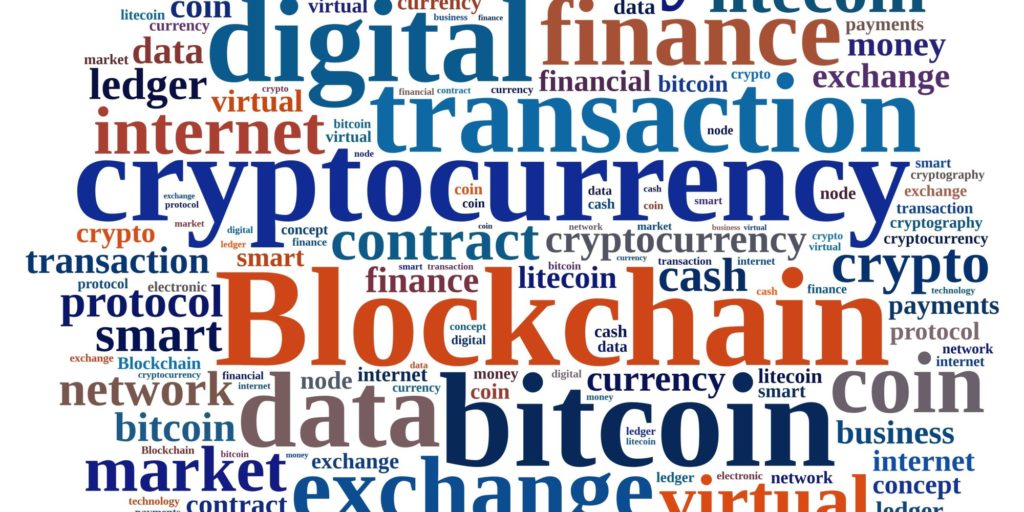
Cryptocurrency is absolutely exploding right now, and it’s no secret why; investors are making buttloads of cash by trading it. But what exactly is cryptocurrency?
WHAT EXACTLY IS CRYPTOCURRENCY?
Cryptocurrency is a virtual or digital asset that can be traded the world over with anyone who has access to a place that sells them. Using a virtual wallet, one can send and receive cryptocurrency – commonly called coins or tokens – by providing a public address that indicates where the funds should be taken from or held.
These transactions are recorded in what is known as “the blockchain”.
A defining feature of cryptocurrency, the blockchain acts as an incorruptible digital ledger that records every single transaction chronologically and is encrypted by cryptography.
As transactions are processed by clients, they form blocks. Blocks are a group of transactions, usually grouped by the time the transaction occurred. Once a block is considered completed, it’s added to the blockchain and another block is created. A block is a permanent store of records that cannot be altered or removed. As more and more transactions are completed, blocks continue to be added, forming a chain – hence “blockchain”.
Another defining feature of cryptocurrency is that it is a decentralized form of currency – it is not issued by any one bank or governmental body, nor does it come from a central source. We’ll see later how this is both a positive and negative trait.
There are literally hundreds of different cryptocurrencies out there right now. Unfortunately, many of them are completely worthless, or are nothing but scams. According to coinmarketcap.com, there are almost 900 actively traded currencies out there, with new ICOs (initial coin offerings) springing up every day.

Here’s a look at the top ten right now, as of September 24th.
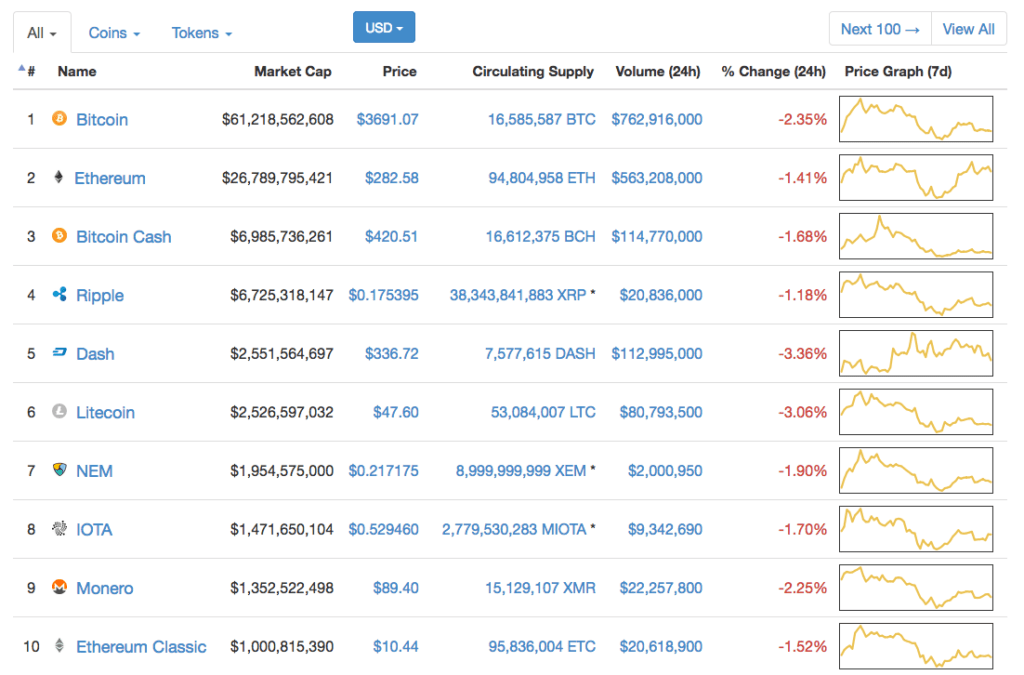
Unfortunately, most of these other hundreds of currencies are a scam and a complete waste of time, so I’m only going to focus on the major ones in this post.

THE MAJOR PLAYERS
These are the most dominant forces in the cryptocurrency market today.
Bitcoin

The first official digital currency, Bitcoin was developed in 2009 by a person or group of people going by the pseudonym Satoshi Nakamoto. Bitcoin was developed as an open-source, digital peer-to-peer payment system. Bitcoin can be sent to anyone who possesses a wallet address and requires no intermediary to use, thus cutting down on drawbacks like long deposit/transfer time, high fees, etc. The goal of bitcoin is to usurp the power of traditional banks and governmental bodies that have control over how people spend, accept, and receive money.
Bitcoin can also be traded on a digital exchange like stocks and bonds.
Ethereum

Ethereum is different from Bitcoin in that it’s not actually a currency – it’s more of a technology. According to Blockgeeks.com, ethereum “is an open software platform based on blockchain technology that enables developers to build and deploy decentralized applications.” These projects then use the Ethereum network as a host.
More from Blockgeeks.com:
“Like Bitcoin, Ethereum is a distributed public blockchain network. Although there are some significant technical differences between the two, the most important distinction to note is that Bitcoin and Ethereum differ substantially in purpose and capability. Bitcoin offers one particular application of blockchain technology, a peer to peer electronic cash system that enables online Bitcoin payments. While the Bitcoin blockchain is used to track ownership of digital currency (bitcoins), the Ethereum blockchain focuses on running the programming code of any decentralized application”
As an analogy, we could say that ethereum is kind of like the internet. It has many, if not an infinite amount, of uses. Bitcoin, on the other hand, is like email. It uses the internet, but it only has one specific use – in this case, the transfer of a digital asset between two people.
Before ethereum, blockchain technology was rather simple, and really only existed to allow users to exchange digital assets from person to person. There were many other possible uses, but developers were somewhat limited by the current blockchain technology. If they wanted to use it for something else, developers had to code it for specifically the use they needed, which took a lot of time and resources. Now, using the ethereum platform, applications can be developed using blockchain technology in the exact way they’re wanted, with easy modifications.
To use the same internet analogy, bitcoin (email) was used to transfer things from person to person, but they knew the technology had many other practical uses. In order to facilitate the development of these other uses, the ethereum platform (internet) was developed.
Another feature of Ethereum is that it can deploy “smart contracts”. These contracts are agreements between two people that are publicly recorded on the blockchain, using the technology to facilitate the exchange of any number of things, whether it’s money, content, property, etc. These contracts are automatically executed whenever specific conditions are met.
Ethereum can also be publicly traded on an exchange like stocks and bonds.
Litecoin

Like bitcoin, litecoin is used as a peer-to-peer payment system. Released in 2011 by former Googler Charlie Lee, if bitcoin is considered the “gold” of the cryptocurrency world, then litecoin is considered the “silver”. It provides many of the same benefits as bitcoin, such as low fees and fast transaction times, but it beats bitcoin in a few ways – it uses the lightning network to allow a greater number of transactions to be processed over the same period of time, facilitating payment approximately four times faster than bitcoin. It also has a greater maximum amount of coins being released.
Litecoin can also be publicly traded on an exchange like stocks and bonds.
HOW CAN I BUY/SELL?
There are a multitude of ways to buy cryptocurrencies, but one of the easiest ways is using a site called Coinbase.
COINBASE
Coinbase allows users to purchase Bitcoin, Ether and Litecoin using either a bank account or credit card. Fees range from 3.99% for a credit card purchase to 1.49% for bank account purchases. To sign up, simply head to Coinbase.com and go to the “Sign Up” page.
But first, if you wanna make yourself (and me) an extra $10.00 in the process, just use this link to sign up here!
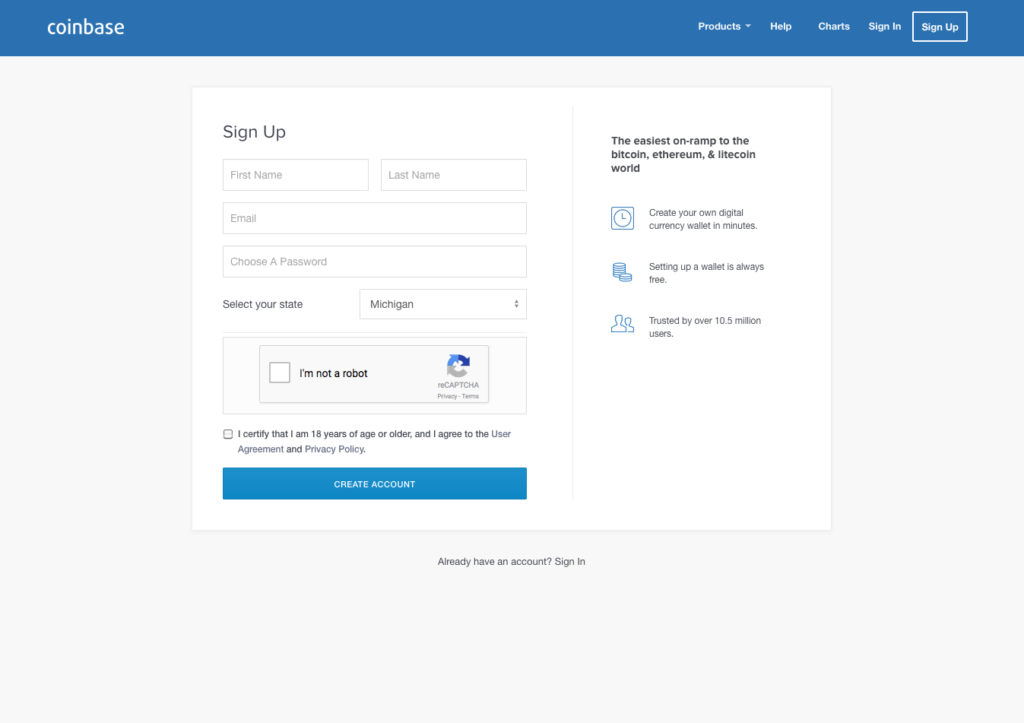
Fill in all the required information and you’ll be sent a verification email.
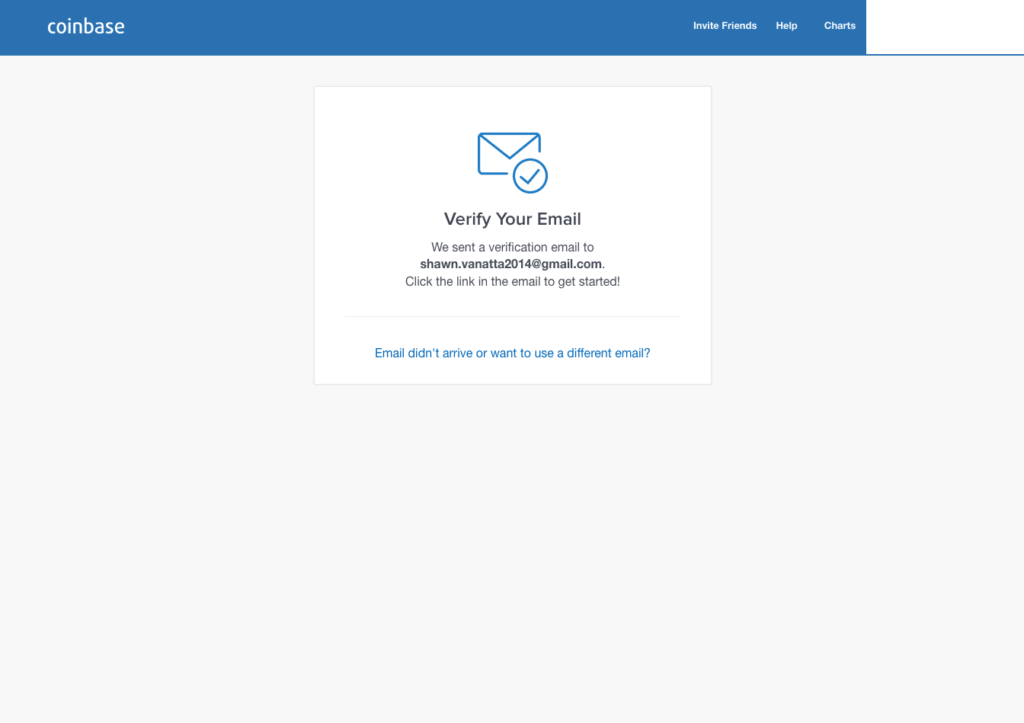
After clicking the link in your email, head back to Coinbase and you’ll be sent to a verification page.
We want to set up as an individual account type.
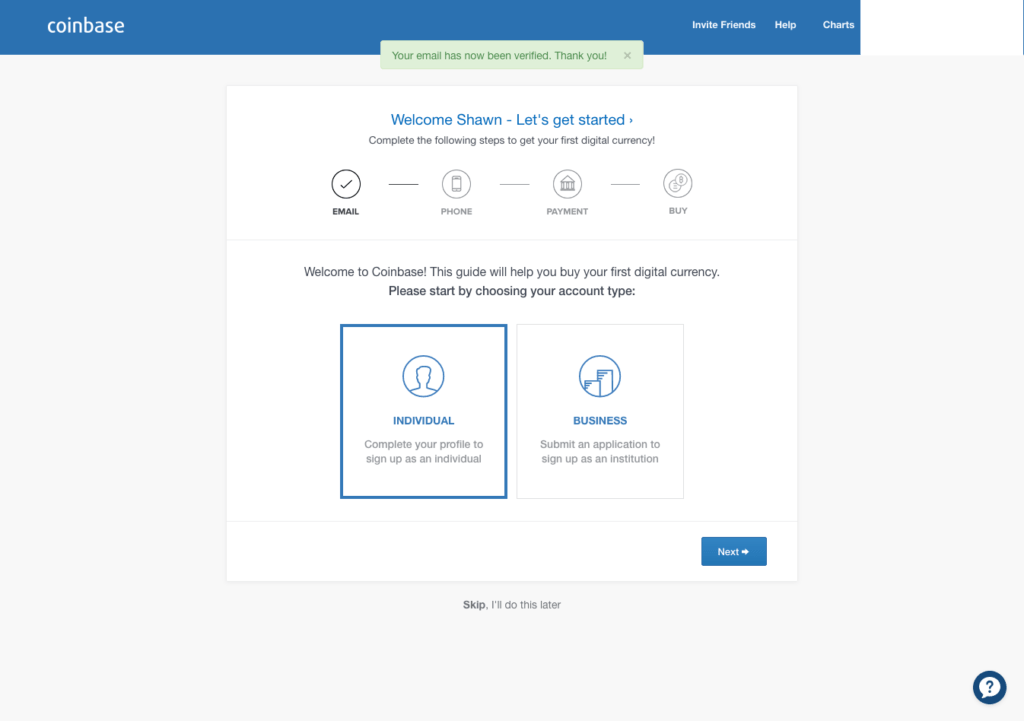
It’ll ask you to put in a phone number for security purposes, though we’re going to want to go a little farther in protecting our account – I’ll detail that in a little bit.
*See note below
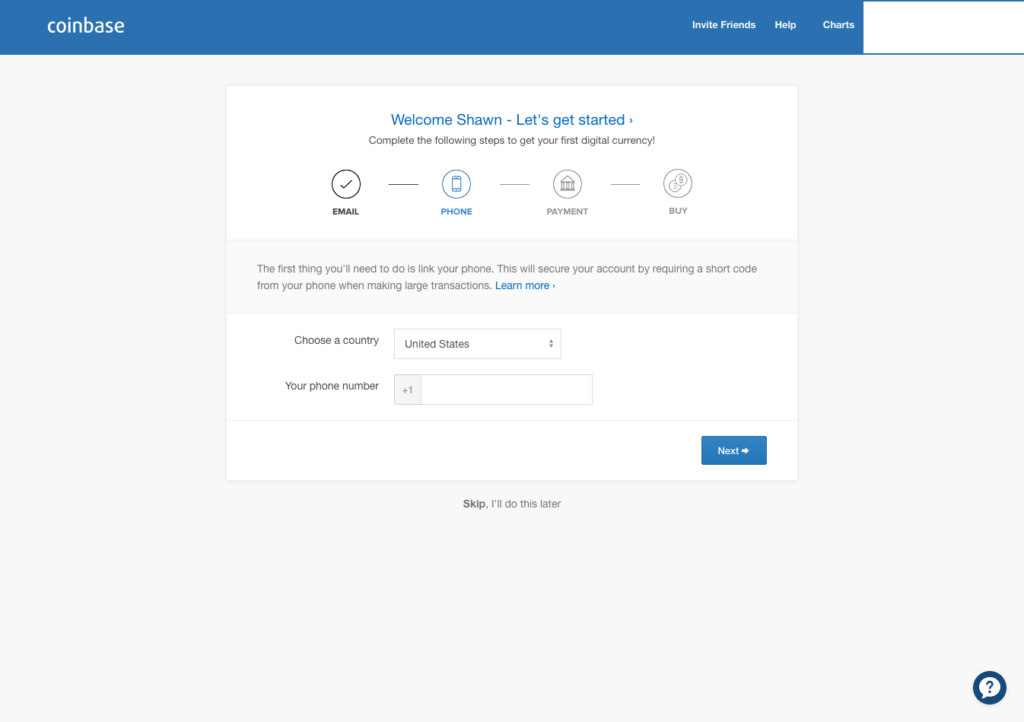
Input your phone number and you’ll be sent a text message to type on screen, as a form of two-factor authentication.
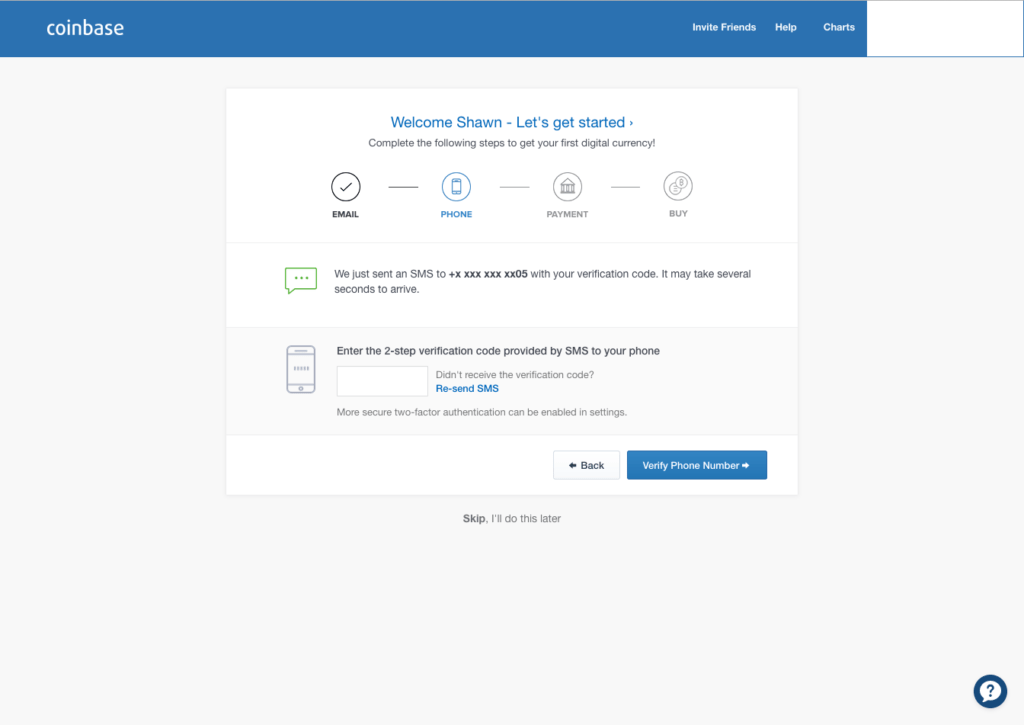
Input the code to be brought to the “Payment” page.
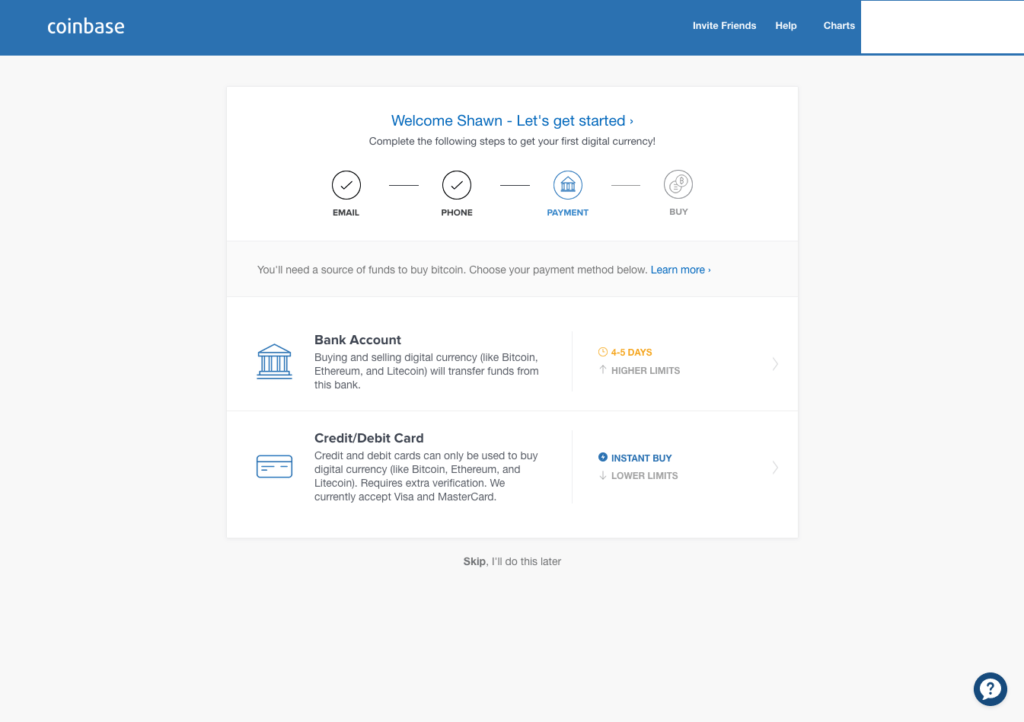
We can use either a bank account or credit card as a form of payment. The main difference between using a bank account and a credit card is that a credit card transaction is instantaneous – you immediately get your token(s), but there’s a limit to how much you can buy. Using a bank account takes longer, anywhere from three to five days to be credited to your account, but you’re allowed to purchase more at once.
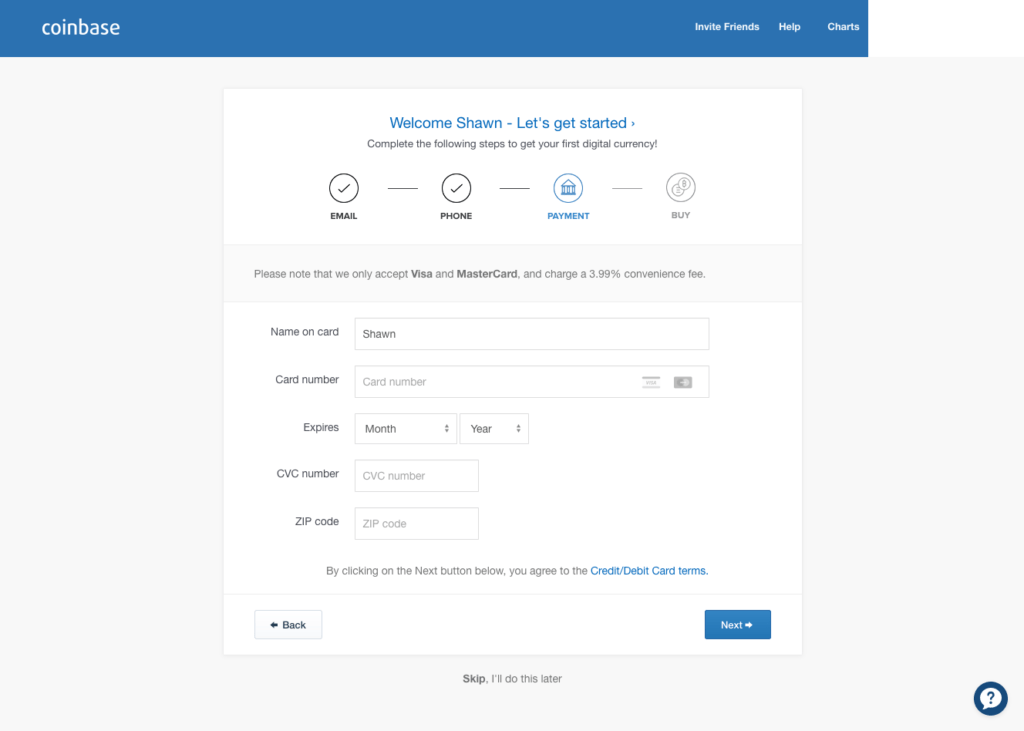
Input all the relevant information and click “next”. The page informs us that in one to two days, two charges will appear on our credit card (or bank account) in order to verify the account.
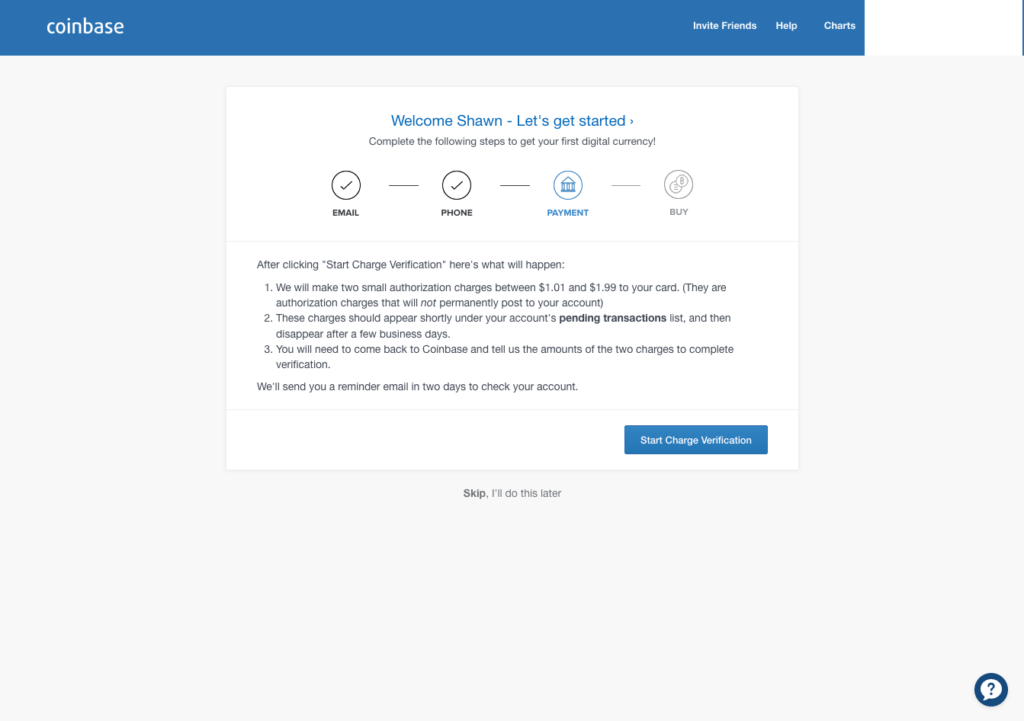
Once these amounts appear on your statement (they’ll be “pending”), return to Coinbase, sign in, and head to the “Settings” section, then the “Payment Method” tab.
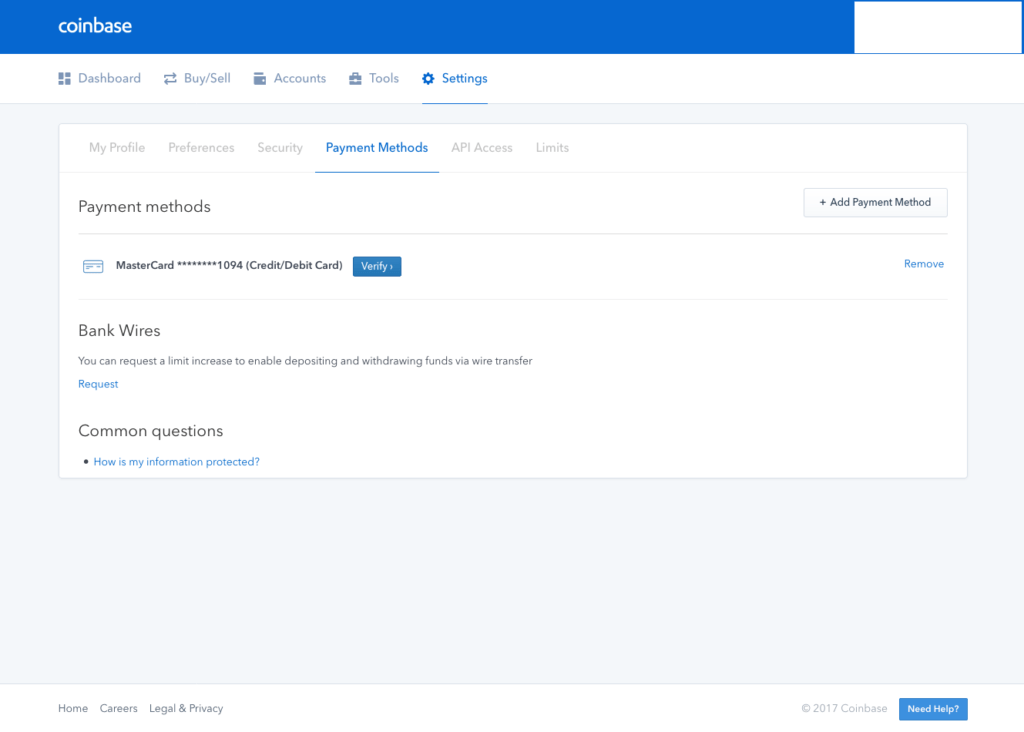
Click “Verify” and enter the two amounts that were charged to your account.
Congrats! We’ve verified our payment method!
At this point we should be able to purchase some cryptocurrency.
Head over to the “Buy/Sell” section in order to initiate our first buy.
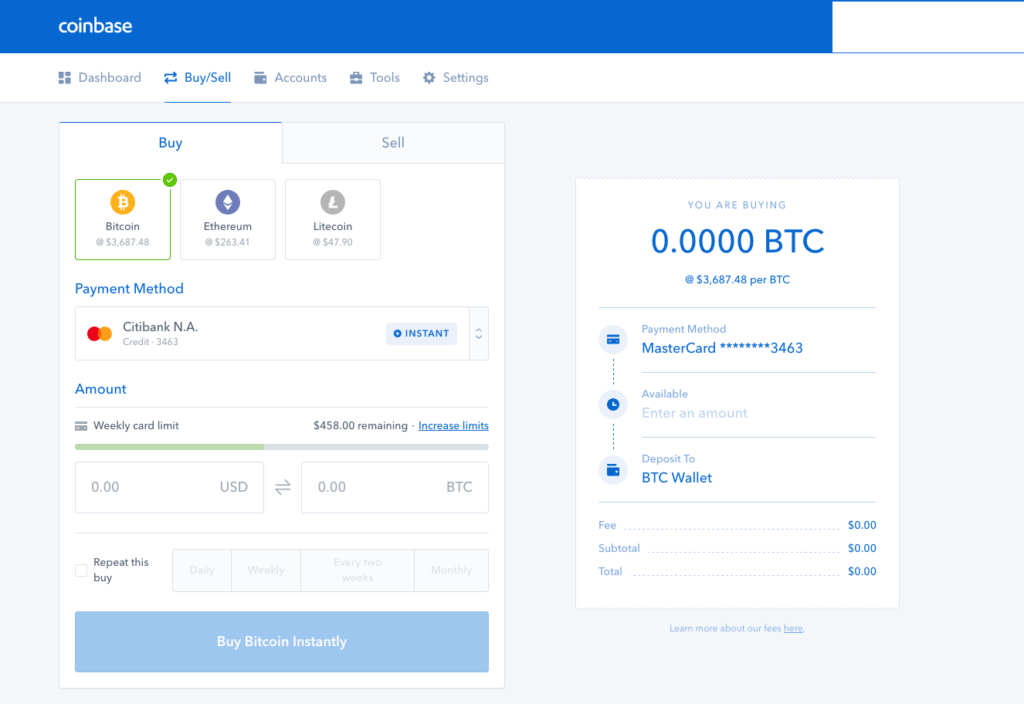
Here you can choose between buying Bitcoin, Ethereum or Litecoin. Let’s purchase one Litecoin.
Indicate your desired payment method. Input the amount you want to buy in dollars and it’ll automatically calculate the exchanged amount in your desired currency, less the convenience fee. For example, if one Litecoin is exactly $50.00, and you input a buy order for $50.00, you will receive slightly less than one full Litecoin because you’re being charged 3.99% on that $50.00.
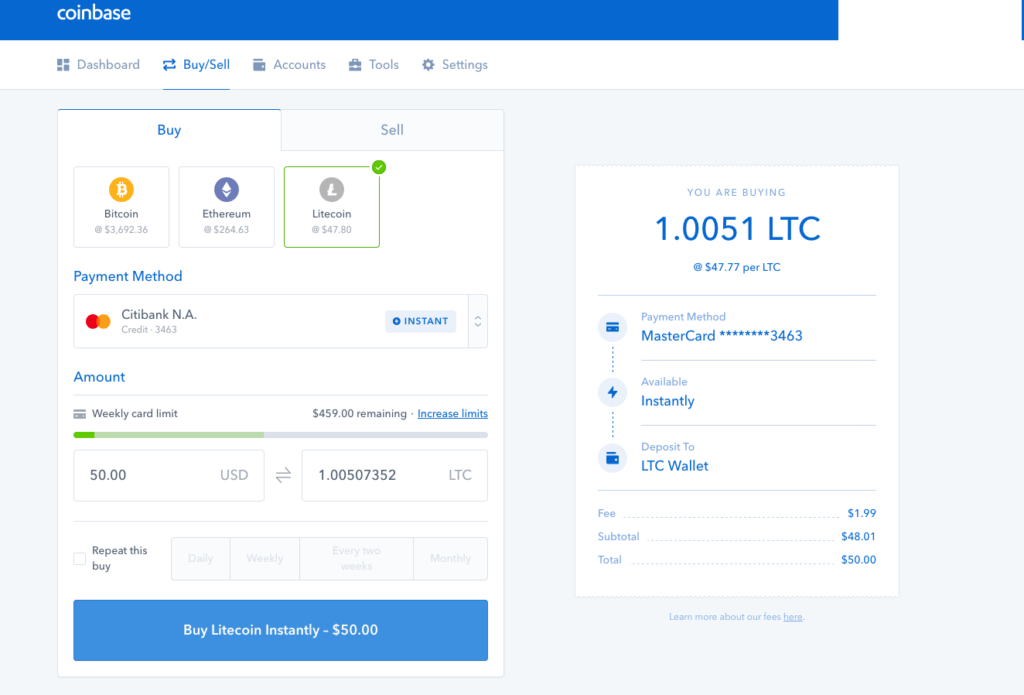
Click “Buy Litecoin” to purchase. It’ll ask if you want to confirm the transaction. Hit “Confirm Buy”.
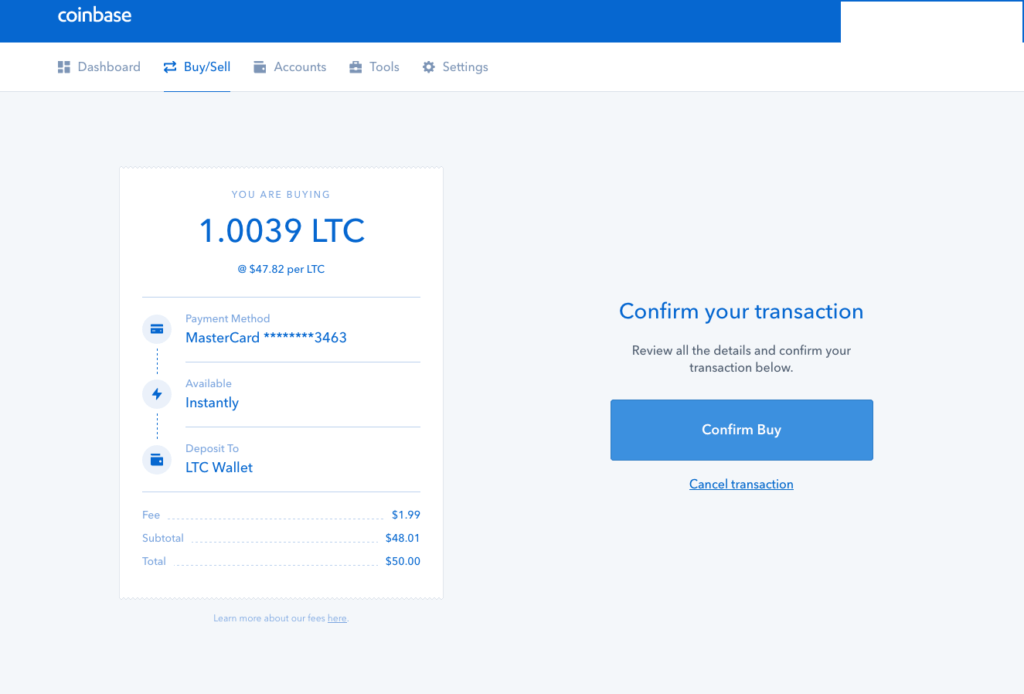
Success!
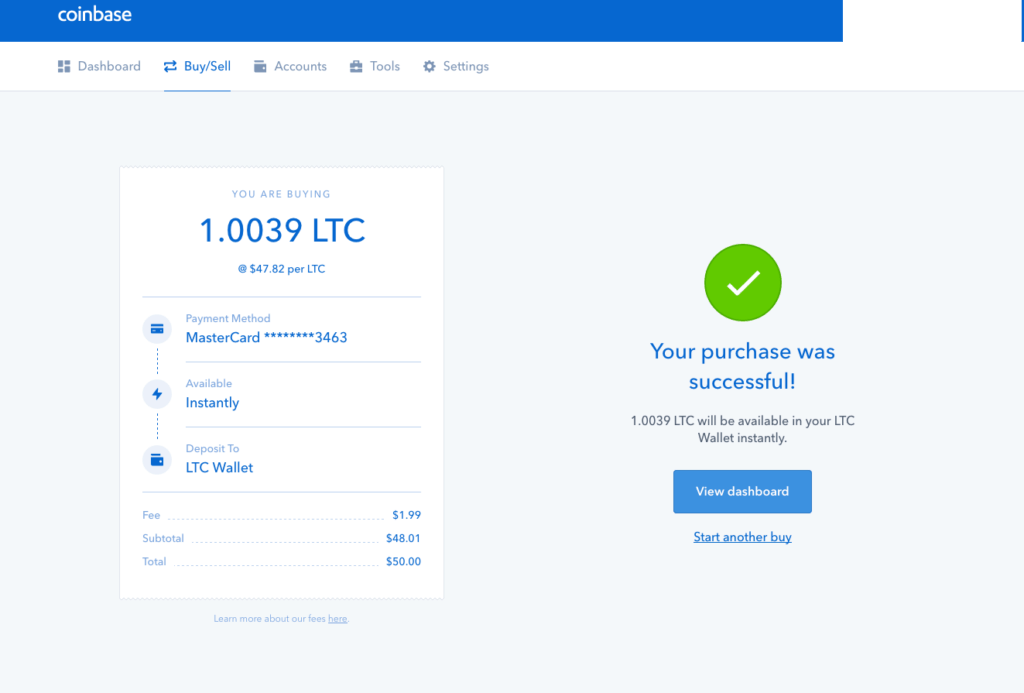
Hooray if you just bought your first cryptocurrency! Woo hoo!
* I strongly encourage downloading the Google “Authenticator” app. In the last few weeks, there have been some major security breaches in the news. There have even been stories of people getting their Coinbase accounts hacked. Unfortunately, the text-to-cell-phone two-factor authentication is not very secure, and it’s possible the code can be intercepted or re-routed by hackers.
Using the Google “Authenticator” app, a randomly generated passcode is sent to the app on your phone. These passcodes are only valid for 30 seconds, and regenerate after the previous code expires. Using this is considered much more secure.
I strongly encourage users to download the Google “Authenticator” app.
GDAX

Another popular American digital asset exchange is GDAX. This is one of the most popular exchanges on the market today. GDAX allows users to trade Bitcoin, Ether and Litecoin like you would on the stock market for a small fee. If you’ve ever used TD Ameritrade or another brokerage service to trade stocks, you’ll probably have no problem here. You can perform all of the typical trade functions here as on other brokerage sites, such as limit buys, stop limits, etc. You can also link your Coinbase account here for free, for easy transfer – fortunately, buying and selling has much smaller fees here compared to buying on Coinbase.com.
Here’s a breakdown of their fees, which varies whether you’re a taker or maker:

From Coinbase.com,
“When you place an order at the market price that gets filled immediately, you are considered a taker and will pay a fee between 0.10% and 0.25% for BTC books and 0.10% and 0.30% for ETH books.
When you place an order which is not immediately matched by an existing order, that order is placed on the order book. If another customer places an order that matches yours, you are considered the maker and your fee will be 0%.”
Whereas Coinbase would charge 3.99% for credit card purchases and 1.49% for a bank account purchase, GDAX charges much smaller fees, especially if you trade often. Note that they only allow one to purchase currency with a bank account.
WHAT ARE THE BENEFITS OF CRYPTOCURRENCY?
FASTER & WIDER REACHING
Generally, when one is trying to send money to another person, whether they’re across the street or across the world, one would have to use a bank as an intermediary. With this comes days of waiting for the money to be taken out of your account, days of waiting for the person to get it, and astronomical fees, simply for moving money around. Using Moneygram or Western Union is unfortunately not much cheaper or easier. As an exmaple, using bitcoin, however, all one needs to send or receive money is their public wallet address. With just this information, one would log into their wallet, input the amount they’d like to send, point to the address where it should go and bam – bitcoin sent/received with only a fractional amount charged as a fee. It doesn’t matter where you or the other person is physically located.
ANONYMOUS
Because transactions are recorded using addresses and not personal information, completed transactions, at least when it comes to the blockchain, are practically anonymous.
SECURE
Because each public address is encrypted with a private key, it is very difficult for tokens to get stolen. As long as you don’t give, store, or show your private key to anyone, the chances of your currencies getting stolen is minimal, as the private key is a long, randomly generated string of numbers and letters.
NO CENTRAL AUTHORITY
Because there is no one person, group, or authority that controls cryptocurrencies, they cannot be manipulated. Anyone can use it!
WHAT ARE THE DOWNSIDES?
VOLATILE
Trading cryptocurrencies is extremely volatile. That may not even be a serious enough word to describe the volatility. In the past month alone, the major cryptocurrencies prices have both reached new highs and plummeted. Bitcoin hit a new high at $4,932.74 in the beginning of September, but then dropped to as low as $3072.93 mid-month – this is a huge price difference! And with China looking to ban the use of Bitcoin, its future is uncertain, most likely causing even greater volatility in the future.
LITTLE INTRINSIC VALUE
While traditional physical money, called fiat, used to be backed by gold, silver, and other tangible assets that had inherent value, no such system exists for cryptocurrencies. Their value rises and falls due to trades, and by themselves, don’t hold much intrinsic value.
NO PHYSICAL FORM
Though some companies have been issuing physical bitcoin, ether and litecoin as a promotional activity, most people who trade will never have access to these physical tokens. Even if they did, because the cryptocurrencies’ values are based on trading, holding these assets in physical form doesn’t mean much.
THEFT
Even though every transaction is recorded on a digital ledger, that doesn’t mean anything when it comes to getting your assets stolen. If someone somehow finds your private key, it’s possible for them to transfer your money to theirs, and unfortunately, there’s no way to get it back.
NO CENTRAL AUTHORITY
Because there is no one person, group, or authority that controls cryptocurrencies, they cannot be manipulated. Anyone can use it! Unfortunately, this also means that if anyone gets access to your coins, there is no one that can help you. Those coins are gone, and no one can help you retrieve them.
HOW SHOULD I HOLD MY CURRENCY?
We can hold our currencies online or offline. Holding them offline is always much safer, but it isn’t always convenient, and one would needs to purchase additional hardware to do so.
ONLINE
There are three main ways we can hold our currencies online:
IN DIGITAL ASSET ACCOUNTS
The most convenient of the options is also the least safe. While it makes it easy for us to trade, cash out, etc., by holding them on the digital asset website like Coinbase or GDAX, there isn’t much protection there. If the site gets shut down, all of your coins would be gone. Both sites do claim to offer insurance for their clients, but it’s difficult to know how this would be enforced as cryptocurrency isn’t highly regulated by the US government.
IN A VAULT
Coinbase offers users the ability to store their tokens in a vault on Coinbase.com. This vault is stored offline, and has numerous security features, such as a 48-hour withdrawal delay and multiple person approval of transactions. It’s totally free – there are no fees for transactions or the storing of your funds. While this all sounds good, it’s still unclear how safe it is, as Coinbase could just go belly up, along with all of your tokens. A little safer than holding them directly in our account on Coinbase.com, but not really much safer.
IN A VIRTUAL WALLET
In a virtual wallet our coins are protected with a private key. As long as no one has access to this private key, our tokens should be safe. They’re typically made up of a combination of over thirty letters, numbers and special characters, making it very difficult to crack. This is one of the safest ways to hold our funds online. One such wallet is “MyEtherWallet.com” which I highly recommend.
OFFLINE
It’s also possible to hold our currencies offline. There are two main ways:
USB DRIVE
This is the use of a USB drive to securely store our wallet information. Typically, for maximum safety, this is done without exposing the USB drive to the internet. This is arguably the safest way to hold our currency. It’s also possible to purchase a USB wallet that works with any number of wallet applications. While I don’t have one myself, the trezor wallet or the ledger nano s both come highly recommended.
PAPER WALLET
We can even go super old school and print off our wallet after we’ve transferred the funds into it. The bitcoin one looks like this:
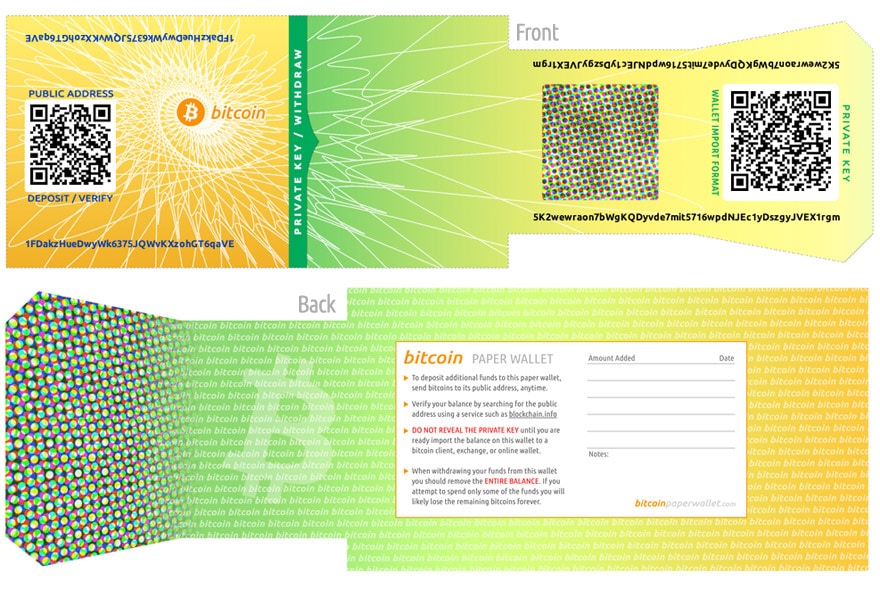
This paper key holds all of the information related to our wallet. The front of the wallet shows both a public and private address. The public address is used to send and receive digital bitcoins directly from or to your wallet. The private key is just that – the private code to your wallet. If someone were to get a copy of this, they could get into your wallet and send your money directly to their own account. Never share your private key with anyone.
I don’t know that I trust myself enough to do it this way, but it’s the ultimate form of protection. The best place to store this would probably be in a safe deposit box at the bank or post office, or in a fire-proof safe at home.
CONCLUSION
Cryptocurrency has the potential to disrupt the entire economic system, and it’s changing how people pay and get paid around the world. The blockchain technology behind it also has many potential exciting uses. It seems obvious that cryptocurrency is here to stay – but what lies ahead in its future? Unfortunately, no one really knows, so for now, it’s best to play it safe.
With that in mind, I have a few final pieces of advice:
1.) NEVER invest more than you can afford to lose. While I believe that cryptocurrency will bounce back from its recent lull and eventually reach new highs, no one knows for sure if or when that will happen. Investing in crypto is sorta like gambling – there’s a potential to lose it all.
2.) NEVER give out your personal crypto-data, whether that’s your private key, login information, or wallet location. Store this info in a secure place and never post it online or send it through email.
Now that you’ve seen all that cryptocurrency has to offer, are you going to buy some? Do you have any questions about it? Shoot me an email or let me know in the comments!
Information gathered from the owner’s respective websites, including bitcoin.com, litecoin.com, ethereum.org and blockgeeks.com. This post may contain affiliate links.


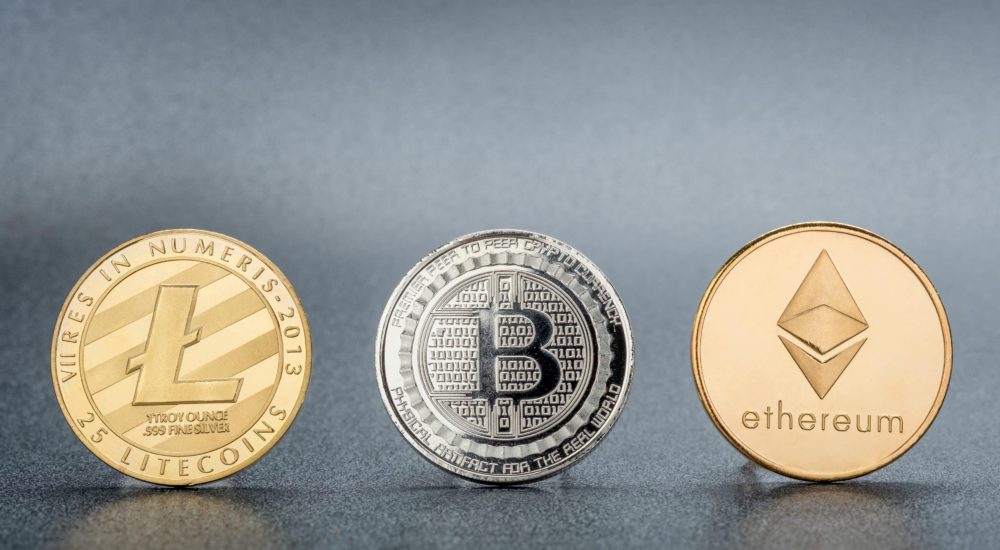
Leave a Reply